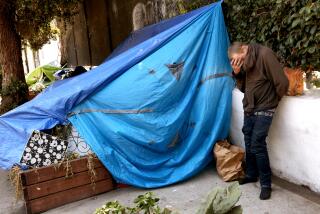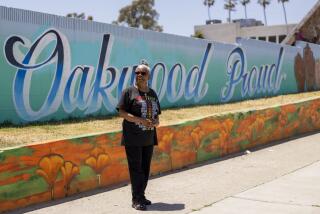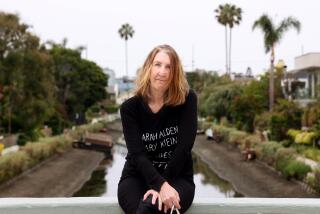An Intimate Look at History : The Oakwood home that belongs to Thelma Tabor Brawley is a reminder of the special relationship her father had with his employer, Abbot Kinney, the founder of Venice.
Thelma Tabor Brawley, a 72-year-old resident of Oakwood, simply has to wake up in the morning to participate in the history of Venice. Her house on the corner of 6th Avenue and Santa Cruz was willed to her father, Irving Tabor, by the cityâs founder, Abbot Kinney.
Irving Tabor served as chauffeur for the wealthy cigarette manufacturer and entrepreneur. Given Kinneyâs peripatetic tendencies, the job meant that the two men were nearly constant companions. And over the years, a strong bond developed between the white tycoon and his black chauffeur.
Itâs all part of the family lore that Thelma Brawley knows so well.
âMy father came out to California from Morgan City, La., in 1910,â Brawley said in a recent interview. âHe was 16 and wanted to see what the great Earthquake of 1906 was all about.â But by the time Tabor arrived in San Francisco, rebuilding had erased nearly all the evidence of the earthquake except for an occasional crack in a sidewalk or building. Besides, Tabor was not partial to the foggy weather, so he headed south to Los Angeles.
At that time, Kinneyâs dream of a âVenice in Americaâ was in its third year of building. Born in New Jersey in 1850, Abbot Kinney amassed a fortune through the production and distribution of Sweet Corporal cigarettes. He moved to the West Coast, invested in beachfront property and set to work to transform his vision into reality.
Inspired by the Columbia Exposition at the Chicago Worldâs Fair in 1893, Kinney and his architects dredged marshes and dug canals. They built an amusement pier and filled it with attractions such as camel rides, sword fights, a hall of mirrors, Hindu fakirs, a miniature railroad and a âTemple of Mirth.â
The public was dazzled, hotels sprang up along Windward Avenue, and the corner of Windward and Trolley Way (now Pacific Avenue) became a favorite destination for Red Car passengers.
Kinney kept building. He constructed a $100,000 saltwater plunge and a $40,000 dance pavilion, strung up 17,000 electric lamps, and built his own home on the Venice Lagoon (now the traffic circles next to the Venice Post Office).
Irving Tabor, meanwhile, landed a job as a janitor on Kinneyâs pier. âOne day, my daddyâs sweeping up down there and Mr. Kinney walks up to him,â Brawley recalled. âMr. Kinney says to daddy: âYoung man, Iâve been watching you--youâre a very good worker. You want to come and work for me?â Daddy tells Mr. Kinney of course he would, and Mr. Kinney says, âCan you drive?â Daddy tells him sure, he can drive. Mr. Kinney says: âIâm having a Model-T shipped out from Detroit in a few weeks and I need a driver. Youâre hired.â â
Thelma Brawley smiled. âWell, my daddy didnât know nothing about driving--heâd never driven a car before in his life. But, being from the South, he wasnât dumb. So he went to Santa Monica, hired a man to teach him how to drive and by the time that Ford arrived, daddy was able to drive.â
The smile broadened as she added: âHe couldnât back up too well, but he could drive.â
Tabor must have gotten his driving technique together before long, however, because Kinney kept him on as his chauffeur until the Venice founder died in 1920. Tabor worked for Kinneyâs widow, Winifred, until her death in 1927, then opened up his own janitorial company, Tabor Maintenance.
Brawley said her father and Kinney had a special relationship.
âDaddy drove Mr. Kinney all over the United States. Wherever Mr. Kinney had to go, daddy would be there with him. And Mr. Kinney refused to stay in any hotel that would not take daddy. If it wasnât good enough for Irving Tabor, it wasnât good enough for Abbot Kinney.â
Kinneyâs egalitarianism apparently wasnât shared by the rest of the white citizens of Venice. When it was discovered that Kinney had willed his house to a black man, there was a hue and cry on the Venice Lagoon--only whites were allowed to live on the banks of the canals. So Tabor was forced to move the house and its garage to Oakwood.
âThat garage used to be quite a lively place,â Brawley said, pointing out her window.
Venice was quite different when Thelma Brawley was growing up in the â20s and â30s. âI went to Venice High School and there was nothing out beyond the school but marshlands and fields,â she recalls. âWe used to have our barbecues down on the cove on the other side of Ballona Creek. All up and down the creek were those Chinese and Japanese vegetable farmers. I remember them, bent over, working their fields, those nice big green vegetables they raised.â
One thing she never lacked was playmates: Her fatherâs six brothers and five sisters had all migrated to Venice from Louisiana and they had produced 35 children. âThe Tabors always helped each other out,â says Navalette Bailey, Thelma Brawleyâs cousin and also a resident of Oakwood. âIf somebodyâs house needed painting, all the men would get together and paint and the women would cook up a big pot of spaghetti.â Nodding, Thelma adds, âThat house would be painted in one day.â
Thelma Tabor Brawley has lived in the Kinney house most of her life. The Tabor clan has mostly scattered now, she said--with just four cousins remaining in and near Oakwood. Irving Tabor died in 1987 at 93, just two weeks after Abbot Kinneyâs daughter, Helen, died.
âHelen was just a doll,â Brawley said.
To the rear of the house, back behind the stairs, is the small room Irving Tabor lived in when he first worked for the Kinneys.
âSee that window there?â Brawley said, pointing. âThatâs how daddy used to sneak in after a night on the town. I suppose he fancied himself quite a man about town. But I always said to him, âWhat were you doing, having to sneak in anyway?â I guess times were different back then.â
The front door opens out to Oakwood. Despite the media hoopla of President Bushâs âThousand Points of Lightâ visit last May and a downswing in the crime rate, the neighborhood is still a tough place.
Brawley has made her contribution to Oakwood, tutoring children after school. âIâve paid my dues on that,â she said.
But, as she looked across 6th Avenue and spotted a young girl ambling down the street, she couldnât help but call out, âYou pick up your feet--a lady does not scuffle down the street that way!â
The girl straightened out her stride and Thelma Tabor Brawley retreated back into the Abbot Kinney house.
More to Read
Sign up for Essential California
The most important California stories and recommendations in your inbox every morning.
You may occasionally receive promotional content from the Los Angeles Times.










